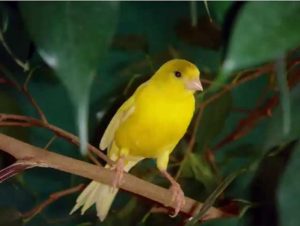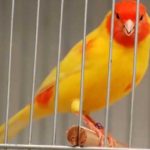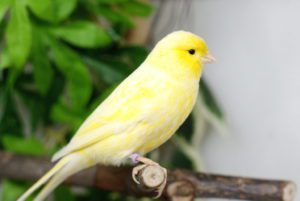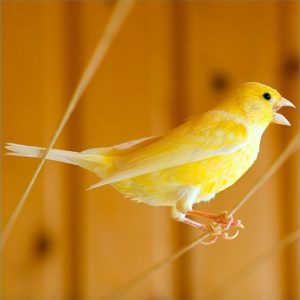
Canary singing: how to teach why you stopped singing and other information
The canary is considered one of the most unpretentious domestic birds and has been very popular all over the world since ancient times. Canary singing, incredibly beautiful and melodic, is the main pride of its owner. In addition to pleasure, the steady rhythmic overflow of a small bird has huge health benefits, helping to eliminate heart palpitations and arrhythmias.
Contents
How a canary sings: sounds on video
Who sings better – female or male?

Males are considered the best
The main “soloists” among canaries are males – kenars. It is they who have extraordinary voice data and the ability to reproduce beautiful and perfect trills. In addition, kenars can imitate other birds, imitate human speech and “repeat” musical fragments played on various instruments. Some canary owners claim that females also try to sing, but in fact their sounds are many times inferior to the incredible trills of the male.
Domestic canaries can sing all year round. But they have a particularly active singing season – from the beginning of November until the end of spring. During this period, the birds first “sing”, gradually develop their voice, and by the end of winter they delight their owners with truly “golden” singing in full force. But with the beginning of summer, canaries usually fall silent, allowing the vocal cords to rest and gain strength for the next season.
How to choose the right songbird

Bright individuals usually do not have singing data
Before starting a canary, it is necessary to clearly define what is more important for the future owner: the beauty of plumage or iridescent trills. After all, as a rule, plain-looking birds are distinguished by the incredible beauty of singing: an outstanding voice is inherited by singing canaries from parents who are specially trained by the breeder. Colored canaries do not have special vocal qualities, because breeders focus on the shades of plumage, absolutely not developing the voice of birds.
An excellent option for those who want to purchase a not very expensive songbird is a canary of the forest tune. These birds are outbred and appeared after an accidental mating of canaries and independently learned to sing pleasantly.
In order for the canary to regularly please its owner with tunes, it is important to consider several nuances before buying:
- The gender of the bird. It is very difficult to determine it, especially in very young individuals: both males and females look almost the same, and they can be distinguished only by their singing abilities. If it is fundamentally important to acquire a canary singer, you should seek advice from an expert in the field of canary breeding, who, carefully observing the bird, will be able to determine its gender;
- Наследственность. The natural inclinations of a bird are an important nuance in her singing “career”. After all, if the bird’s father was a rather mediocre singer, it is unlikely that the son will surpass him with his talent. Therefore, if possible, it is worth observing the voice of the canary parent: it is desirable that it be sonorous, strong, clean and gentle at the same time;
- The number of birds. Canaries are peaceful and calm birds that do not like loneliness. When purchasing a pair, it is important to consider that the constant presence of a female nearby and the absence of the need to attract her attention can reduce the singing abilities of a kenar. But during the period of incubation, the male will sing as penetratingly and with inspiration as ever;
- Time of year and age. Experts recommend buying singing canaries at the age of 4-5 months, and best of all – in December. Just by this time, the first molt will pass at the kenar and the voice will begin to grow stronger. Also, by December, birds, as a rule, are already beginning to fully master the art of singing.
How to teach a canary to sing

A bird can start its arias from early morning
The quality of canary singing directly depends not only on heredity, but also on proper training. In order to maximize the singing potential of a bird, it is important to observe certain conditions:
- Finding a canary in a small separate cage. It is best to transplant the bird after molting. When separating a male from a female, he can experience severe stress from separation and completely refuse to sing. To prevent this from happening, you need to leave the cages next to each other, and after a few weeks – put one on top of the other, fencing off the floor-ceiling with cardboard so that the birds do not see each other and are not distracted from training;
- Starting classes at a young age, when the flexibility and learning ability of the bird is at its highest level;
- The physical condition of the kenar: any ailment or illness must be eliminated before training begins;
- Bird nutrition. It should be balanced and contain all the necessary vitamins and minerals (both overeating and hunger are dangerous).
To train and develop the singing abilities of kenars, you can use:
- various musical instruments (pipes, pipes, whistles);
- recordings of trills of the best kenars.

In order to calm down the singing canary, you will have to throw a dense fabric over the cage
An important condition for achieving a quick result is the correct organization of classes. In order for the kenar to better perceive and assimilate the included recordings or “live” musical fragments, its cage must be darkened with curtains. Twilight will allow the bird not to be distracted by extraneous sounds and fully concentrate on the lesson. It also requires perfect silence. Otherwise, the attention of the bird will be scattered, and different sounds may be perceived as part of the melody. The ideal time to practice is in the morning. Recordings should be listened to for about 40-50 minutes four or more times a day with breaks.
What to do if the canary squeaks instead of singing or does not sing at all
A bird sitting in one place for a long time should cause concern. This is how sick individuals behave
If a canary instead of an iridescent trill begins to make squeaking sounds, or even stops completely before doing anything, it is important to find the reasons for this behavior. Often they can be:
- molting, during which the bird loses a lot of strength, becomes lethargic, passive, sleepy. As a rule, this period passes, and the normal state is restored;
- stress experienced by the bird (sharp loud sounds, jumping on a cat’s cage, dog barking, etc.). In this case, you need to leave the bird alone for a while, moving the cage to a quiet, dim room;
- obesity, in which the bird begins to move little and stops singing. A two-week diet (on corn or rice porridge) with the obligatory enrichment of food with vitamins and means to increase immunity will help normalize weight;
- the spread of tracheal mites caused by a violation of the sanitary conditions of poultry keeping. Consulting a veterinarian and carefully treating the cage with steam or boiling water will help solve the problem;
- bird disease, which can be caused by drafts, dry air, unsuitable conditions. As a rule, a sick canary not only stops singing, but also coughs, wheezes, goes bald, refuses to eat, sitting in one place for a long time. It is important to understand that any violation of the bird’s behavior requires immediate veterinary attention.
Canaries are excellent singers that are easy to train. Compliance with proper living conditions, rational nutrition, regular exercise, and most importantly, patience and love will sooner or later allow the owners of this talented domestic bird to enjoy its inspirational trills and modulations.




